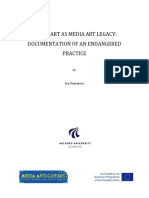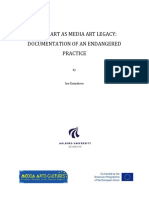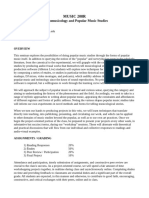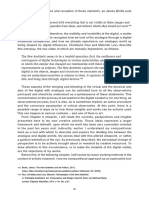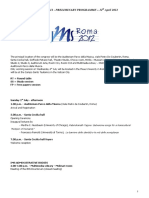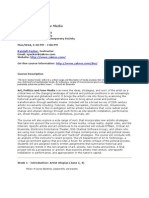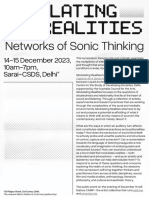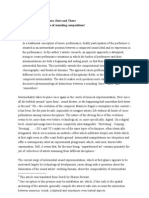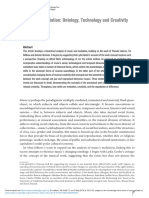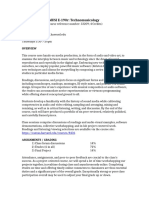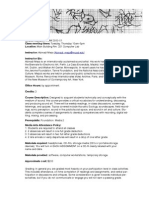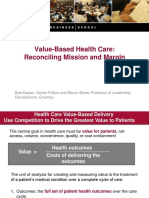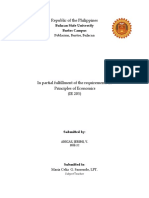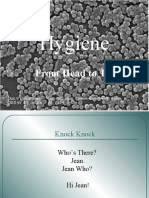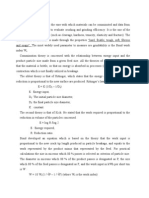F21-Heilgendorff_SE
Sound Studies and Sonic Arts
Summer Semester 2021
Phase Focus
Module Theory
Course Title Cultural Studies and Artistic Research within Sound Studies | Seminar
Course Times and Location Thursday (22.4., 15.5., 20.5., 10.6., 1.7., 8.7. additional session 15.5) | time see
schedule | online
Instructor PD Dr. Simone Heilgendorff
Email simoneheilgendorff@gmx.net
Office Hours Upon request after class
Course Description
This seminar provides combined space for the discussion of and encounter with current socio-cultural, aesthetic
and artistic topics related to sound art. As a reference texts from the first decades after WWII by prominent
authors such as Marshall McLuhan, R. Murray Schafer, and Laszlo Moholy-Nagy will be studied. Other sessions will
be dedicated to socio-cultural approaches of our time, such as provided by Ray Oldenburg (third places), Georgina
Born (mediation, gender, digitization), as well as Doris Bachmann-Medick and Erika Fischer-Lichte (cultural turns).
In addition, we will explore examples preceding and preparing sound art activities by members of the
interdisciplinary New York Schools, the Dream House project by La Monte Young and Marian Zazeela and projects
by Pauline Oliveros. One unit will be dedicated to issues and basics of artistic research. The seminar also allows
space for experiments with some participants’ own research projects.
The seminar will be most rewarding for those students who a) want to extend their knowledge on socio-cultural
perspectives on sound art, b) are interested in getting to know original texts and artistic projects in contemporary
music from the time before sound art was conceptualized as a genre, and c) who want to consolidate and expend
their knowledge and practice in artistic research.
Requirements for Attending
Maximum of 15 students.
Exam / Credit Points
Passing the first assignment is mandatory for submitting the second assignment.
2CP (graded: Theory): Regular attendance, homework, and a 45’ presentation with handout in class;
Consecutive assignment leading to 4CP (optional; graded: Theory; grading: mean of both grades): term paper
(8,000 words) due 1 Nov. 2021.
Property of the SoundS faculty. Published with kind permission of the author.
� F21-Heilgendorff_SE
Sound Studies and Sonic Arts
Schedule
Thursday April 22, 15 to 19h | Session 1
15 to 17: Introduction
17 to 19, Socio-cultural Approaches 1:
Original Sources on and in Sound Art/Sound Experience 1: R. Murray Schafer (1977) Soundscape (“Introduction,”
“Natural Soundscape,” and “Glossary”)
Saturday May 15, 10 to14h | Session 2
10 to 12, “Roots” of Sound Art:
American Experimental Tradition/The New York Schools (intro to selected artists, reading: Steven Johnson
(2002) “Introduction”)
12 to 14, “Roots” of Sound Art cont.:
John Cage’s concepts of silence and technology, reading Cage’s texts “Listening to Music” (1937) and “Art
and Technology” (1969)
Thursday May 20, 15 to 19h | Session 3
15 to 17h, Original Sources in the Context of Sound Art 1:
1) Richard Kostelanetz Theatre of Mixed Means (excerpts, 21970)
2) Marshall McLuhan Understanding Media, Routledge (excerpts, 1964)
17 to 19h, Early examples from the Border Region of Sound Art and Contemporary Music I:
Pauline Oliveros: her music, performances, and her “Deep Listening” concept and educational model
Thursday June 10, 15 to 21h | Session 4 and ½ Session 5
15 to 17, Socio-cultural Approaches 2:
The Concept of “Third Places” by Ray Oldenburg (The Great Good Place, introduction, first edition 1989)
17 to 19h, Artistic Research Topics 1: Criteria, Methods and Settings
1) Gerald Bast “Can Artists be Researchers? A Necessary Discussion on the Obvious.” (2011)
2) Institutions and doctorate programs for artistic research
3) The Society of Artistic Research (SAR), the Journal of Artistic Research (JAR) and the Research
Catalogue of the Society of Artistic Research (www.researchgate.org)
19 to 21h, Artistic Research Topics 2: A Sample Project from the Field
Barbara Lüneburg Transcoding … (2018), a PEEK project in Austria (2014–18)
Thursday July 1, 15 to 21h | ½ Session 5 and Session 6
15 to 17h, Time for Experiments in Research:
Presentation of outlines for papers in this class, student research projects and/or existing research projects
17 to 19h, Socio-cultural Approaches 3:
Property of the SoundS faculty. Published with kind permission of the author.
� F21-Heilgendorff_SE
Sound Studies and Sonic Arts
1) The concept of “cultural turns:” reading D. Bachmann-Medick, Cultural Turns (excerpts from the
English translation of her book, 2016, German original 2006)
2) The performative turn in particular: following Erika Fischer-Lichte The Transformative Power of
Performance. A New Aesthetics (excerpts from the English translation of her book, 2008)
19 to 21h, Original Sources in the Context of Sound Art 2:
Laszlo Moholy-Nagy and the Bauhaus concept, reading from his Vision in Motion (1947)
Thursday July 8, 15 to 19h | Session 7
15 to 17h, Session 13 | Socio-cultural Approaches 4:
Understanding the mediation of contemporary music and sound art after Antoine Hennion and Georgina
Born (reading Born 2005) OR
Gender in contemporary music and sound art, reading Georgina Born and Kyle Devine “Gender, Creativity
and Education in Digital Music and Sound Art” (2016)
17 to 19h, Session 14 | Early Examples from the Border region of Sound Art and Contemporary Music II:
La Monte Young’s and Marian Zazeela’s Dream House project (since 1969)
Supporting Media
Savin-Baden, Maggi, and Claire Howell Major. “Arts-Based Approaches.” In Qualitative Research: The Essential
Guide to Theory and Practice, 288–304. Milton Park, Abingdon, Oxon; New York: Routledge, 2012.
Assmann, Aleida. “Memory, Individual and Collective.” In The Oxford Handbook of Contextual Political Analysis,
edited by Robert E. Goodin and Charles Tilly. Oxford Handbooks of Political Science. Oxford: New York: Oxford
University Press, 2006. https://doi.org/10.1093/oxfordhb/9780199270439.003.0011.
Bachmann-Medick, Doris. Cultural Turns: New Orientations in the Study of Culture. Berlin: De Gruyter, 2016.
Bast, Gerald. “Can Artists Be Researchers? A Necessary Discussion on the Obvious.” In Art and Research: Can Artists
Be Researchers?, edited by Gerald Bast, Jürgen Mittelstrass, and Janet Ritterman, 183–196. Edition Angewandte.
Wien: SpringerWienNewYork, 2011.
Born, Georgina. “On Musical Mediation: Ontology, Technology and Creativity.” Twentieth-Century Music 2, no. 1
(March 2005): 7–36. https://doi.org/10.1017/S147857220500023X.
Born, Georgina, and Kyle Devine. “Gender, Creativity and Education in Digital Musics and Sound Art.”
Contemporary Music Review 35, no. 1 (January 2, 2016): 1–20. https://doi.org/10.1080/07494467.2016.1177255.
Craenen, Paul, and Helen White. Composing under the Skin: The Music-Making Body at the Composer’s Desk.
Orpheus Institute Series. Leuven, Belgium: Leuven University Press, 2014.
Eckhardt, Julia, and Leen De Graeve. “Gendered Music and Sound Art.” In The Second Sound: Conversations on
Gender and Music, 48–68. Gent: Umland, 2017.
Johnson, Steven, ed. The New York Schools of Music and Visual Arts: John Cage, Morton Feldman, Edgard Varèse,
Willem De Kooning, Jasper Johns, Robert Rauschenberg. Studies in Contemporary Music and Culture. New York:
Routledge, 2002.
Property of the SoundS faculty. Published with kind permission of the author.
� F21-Heilgendorff_SE
Sound Studies and Sonic Arts
Kostelanetz, Richard. The Theatre of Mixed Means: An Introduction to Happenings, Kinetic Environments and Other
Mixed-Means Performances. Nashville, Tenn.: Archae Ed., 1981.
Langer, Susanne K. Philosophy in a New Key: A Study in the Symbolism of Reason, Rite and Art. 3. ed. Cambridge,
Mass.: Harvard Univ. Press, 1993.
Lüneburg, Barbara. TransCoding: From “Highbrow Art” to Participatory Culture: Social Media - Art - Research.
Culture & Theory, volume 155. Bielefeld: Transcript, 2018. Project website: http://www.transcoding.info/
McLuhan, Marshall. Understanding Media: The Extensions of Man. Repr. Routledge Classics. London: Routledge,
2010 [1964].
Mersch, Dieter. “Meta/Dia Two Different Approaches to the Medial.” Cultural Studies 30, no. 4 (July 3, 2016): 650–
79. https://doi.org/10.1080/09502386.2016.1180751.
Moholy-Nagy, László, and Herwig Engelmann. Vision in Motion. 1. ed. Chicago: Paul Theobald and Company, 1947.
Murphy, Siobhan. “Writing Performance Practice.” In The Exposition of Artistic Research in Academia, edited by
Michael Schwab and Henk Borgdorff, 177–190. Leiden: Leiden University Press, 2014.
Oldenburg, Ray. The Great Good Place. Cafés, Coffee Shops, Bookstores, Bars, Hair Salons, and Other Hangouts at
the Heart of a Community. Da Capo Press, 19993.
Reckwitz, Andreas. “3. Centrifugal Art.” In The Invention of Creativity: Modern Society and the Culture of the New,
57– 84. Malden, MA: Polity, 2017.
Reckwitz, Andreas. “7. Creative Cities.” In The Invention of Creativity: Modern Society and the Culture of the New,
173–199. Malden, MA: Polity, 2017.
Schafer, R. Murray. The Soundscape: Our Sonic Environment and the Tuning of the World. Rochester, Vt.: Destiny
Books, 1993 [1977].
Society of Artistic Research. Research Catalogue of the Society of Artistic Research (www.researchgate.org)
Zembylas, Tasos, and Martin Niederauer. Composing Processes and Artistic Agency: Tacit Knowledge in Composing.
Abingdon, Oxon; New York, NY: Routledge, 2017. (eBook)
Repository
There will be an online repository via Moodle for the class.
Property of the SoundS faculty. Published with kind permission of the author.



